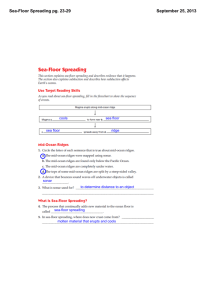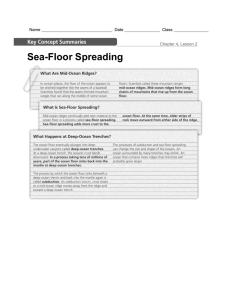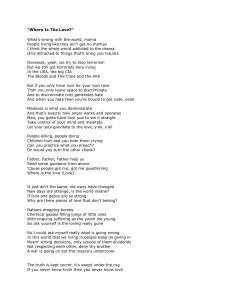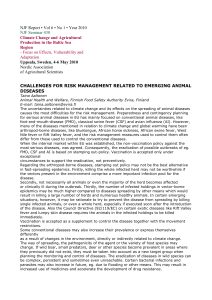i OIL SPREADING OVER WATER Walter Suchon
advertisement
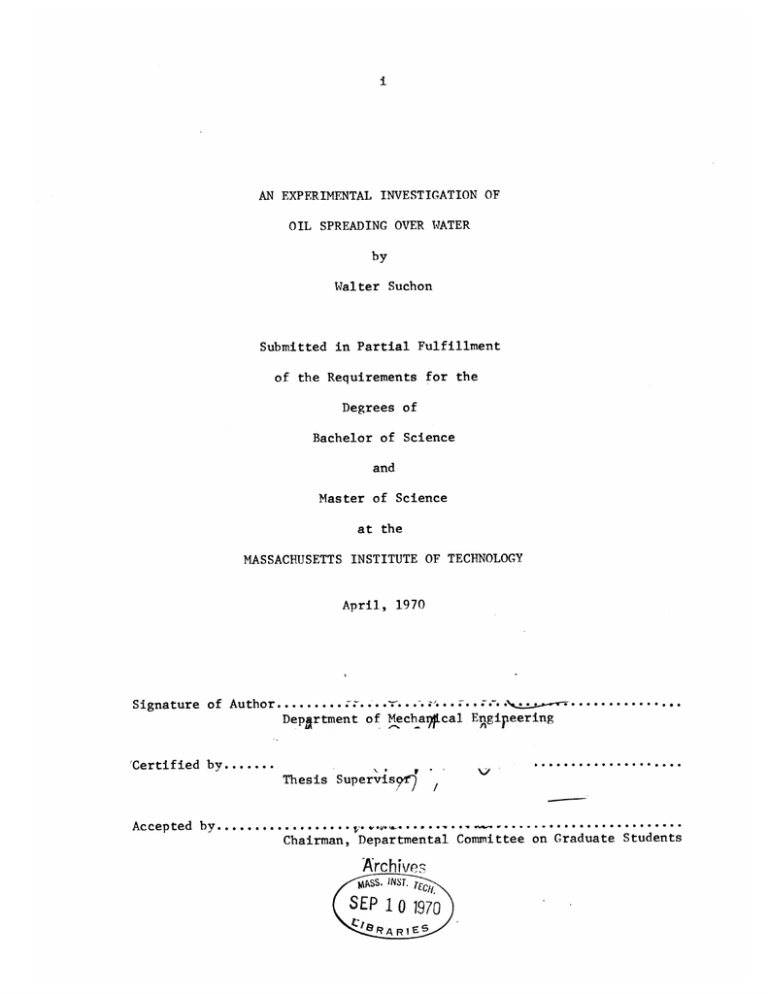
i
AN EXPERIMENTAL INVESTIGATION OF
OIL SPREADING OVER WATER
by
Walter Suchon
Submitted in Partial Fulfillment
of the Requirements for the
Degrees of
Bachelor of Science
and
Master of Science
at the
MASSACHUSETTS INSTITUTE OF TECHNOLOGY
April, 1970
Signature of Author..........-.....
-r....r...
Depgrtment of Mecha
.;
.-.. %..
-
...............
cal Engipeering
'Certified by.......
Thesis Supervis
----.
-...
Accepted by..................a..... ......................
Chairman, Departmental Committee on Graduate Students
Archives
MAPSS.
INST. ritc
SEP 10 1970
CeRA RIS
AN EXPERIMENTAL INVESTIGATION OF
OIL SPREADING OVER WATER
by
Walter Suchon
Submitted to the Department of Mechanical Engineering on
24 April, 1970, in partial fulfillment of the requirements for the
degree of Master of Science.
ABSTRACT
One-dimensional experiments were performed to determine the
spreading rates of oil over water.
The viscosity of the water was
modified to enable both gravity-inertia and gravity-viscous spreading
to be observed in a 7' tank.
The resulting data was in excellent
agreement with Fay's order of magnitude theory, and the numerical
spreading coefficients were determined.
Thesis Supervisor:
David P. Hoult
Title:
Associate Professor of Mechanical
Engineering
iii
Acknowledgements
The author sincerely thanks Professor David Hoult for his enthusiasm and guidance in the course of this work; also, Professor
James Fay for his keen insight into the experiments; Miss Sara
Rothchild for her help in preparing the manuscript; and last, but
not least, my fellow members of the laboratory for their assistance
and companionship.
This research was sponsored Jointly by the U.S. Coast Guard,
DOT-CG-01-381A, and the Department of the Interior, FWPCA Grant No.
14080 ESL.
iv
Table of Contents
Title Page
Abstract
Acknowledgements
Table of Contents
11
iii
iv
List of Symbols
v
Introduction
1
Theory
3
Experiments
5
Results
8
Conclusions
11
Appendix I
12
Appendix II
13
References
15
Figures
16
List of Symbols
d
channel depth
g
2
gravity, 32.2 ft./sec.
h
average oil thickness
h
initial oil thickness
hF
oil thickness in front of dam prior to release
k~
overall slick length
0
R0initial
slick length
0
kt
slick length at transition, = (AgL21/3 Tt2/3
L
length
T
time
T
time to transition, = L 8
u
oil front velocity
V
oil volume
w
channel width
t
6wboundary
7 /(Ag) 2 7
Vw
layer thickness of base fluid
A
percentage density difference
P0
absolute viscosity of oil
ywabsolute
.v 3/7
viscosity of base fluid
v
W
kinematic viscosity of base fluid
p
density of base fluid
aY
surface tension
-
1
-
I. Introduction
Oil spills are the object of deep concern these days as major
accidents, such as the Torrey Canyon in England and the well blowouts both in the Santa Barbara Channel and the Gulf of Mexico, have
brought to the public's attention the damage resulting both to the
local marine life and to the shoreline itself.
A troubling fact is,
however, that the threat of potential spills grows with the current
construction of deep sea drilling platforms and the advent of supertankers plowing dangerous Artic waters, while our present technology
is still in the state of using primitive booms or even straw to sweep
up the oil.
Of vital importance in advancing this technology is a knowledge
of the spreading rates of an oil slick.
With this information, clean
up personnel could have on hand an estimate of the area of the slick
at any time after the spill occured, and thus would know what quantity
of boom or chemical dispersant to deploy.
dealt with this problem.
Three previous papers have
Abbott (1,2) deals only with the inertial
spreading of the oil, and treats the advancing front like a dam break
flow.
He also conducted several steady state experiments.
considers three different spreading states of the oil.
Fay (3)
The first state
is like that studied by Abbott, in which the driving gravity force is
balanced by inertia forces.
In the second state the gravity force is
balanced with viscous forces in the water.
And in the last state, we
have surface tension, tending to spread the oil, opposed by viscous
forces.
- 2 The intent of this thesis was to verify the results of Fay for
the first two spreading regimes, i.e. the gravity-inertia and the
gravity-viscous.
In the following pages, first the order of magni-
tude theory of Fay is presented for the one-dimensional flow of oil
over calm water (Chapter II); next the details of the experiments
conducted in the M.I.T. Fluid Mechanics Laboratory are described
(Chapter III); and finally, the results for both regimes are presented (Chapter IV).
- 3 II. Theory
Here we rederive the results of Fay for a one-dimensional
flow of a volume of oil released from a point source in still water.
If the water is of density p, then the oil has density (1 - A)p,
where A is typically 1/10.
Initially we assume the important forces
will be the driving gravity force and the retarding inertial force,
or,
F ~F
i
(1)
Using a characteristic dimension 2, the slick length, and a characteristic time, T, we have,
Fi
-
p
(2)
thw
T
and,
F
~ {p - (1 - A)p} gh * Lw
(3)
where
(4)
h = V/kw
the average thickness of the oil.
(5)
L2 = V/w
then equation (1)
If we set
reduces to,
k ~ (gL 2 1/3 T2/3
(6)
- 4 This model of the first regime of spreading assumes that there
exists no energy coupling between the two fluids, i.e. the oil might
be considered a non-viscous fluid of density AP proprogating over a
flat plate.
As the slick continues to spread, one would expect the friction
or viscous forces to become important in flow retardation, or
F
v
~ F
(7)
.
g
With p'/yw >> 1, we assume that all the shear will be in the water
and that the velocity profile in the oil is constant (see Fig. lb).
A characteristic y-dimension is the boundary layer thickness 6 ,
which we take to be V7Y.
w
F
v
(
)
Then we have
Z/T y
(Pw) (V T)l/
Combining equations (3),
(8)
(8), (7), we arrive at the second spreading
equation,
(AgL 4)
T 3 /8
(9)
w
In this second regime we have assumed that there does exist a coupling
between oil and water, the gravitational potential energy of the oil
being dissipated by the water.
- 5 III.
Experiment
A series of experiments were performed to see if the theory
presented in the preceding section gives a reasonable representation of the flow.
The most essential features of the theory to be
verified were:
a)
the power of T with which Z, the slick length, varies in
each spreading regime,
b)
the dependence of k on the volume of oil, wL2
c)
the transition from the inertial to viscous spreading regime.
The experiments consisted basically of releasing a known volume
of oil dammed up at one end of a long, uniform channel and timing its
progress as it moved across the water's surface.
The apparatus
employed was a 7' by 4' tank with 1' high glass walls along its length.
A third, movable plywood wall was placed inside narrowing the tank width
w and thereby reducing oil volumes and the size of the mechanical dam.
This dam, located 1' from the channel's end, was an 1/8" aluminum plate
mounted in guides, carefully fitted to prevent any seepage of oil and
yet loose enough to allow quick manual removal to start the flow.
When
needed, another barrier was fixed in place behind the dam to alter the
starting length k of the pool of oil.
In a typical experiment, oil
was poured on the water behind the dam; the volume was then determined
by taking the product of k , w, and h0, the initial depth of the oil
pool as measured with a rule through the glass outer wall.
To record
the oil's movement down the channel, an X-Y chart recorder with a time
base was employed.
After activating the horizontal time sweep, a small
blip could be left on the paper by closing a push button switch.
- 6 Dark vertical lines had been drawn on the outside glass and inside
plywood tank walls at 6" intervals from the dam front; as the dam
was withdrawn, releasing the oil, a timing mark was recorded, and
subsequently as the oil wave front reached each 6" line (see Fig. 1).
The primary consideration in selecting the fluids appropriate
for the experiment was that it be possible to conduct both gravityinertia and gravity-viscous tests within the limitations imposed by
the tank's length.
It was proposed to have the transition point,
i.e. the spreading distance at which viscous rather than inertial
forces become important in flow retardation, occur approximately
half-way down the channel, or 3.5' with t
o
= 1' and h
0
= 1".
Since
an estimate for the transition time may be obtained by finding the
time at which equations (6) and (9) predict the same length,
T
tw
= L
/(Ag)2/7 V 3/7)
and for the transition length,
t = (gL 2)1/3 Tt2/3
by increasing the viscosity V
of the base fluid it should be possible
to induce viscous shear, and hence transition, sooner in the flow.
A
75% glycerine-water solution was used, with pw = 30 centipoises,
sp.g. = 1.2.
This was maintained at a 8.5" depth.
black oil, Mobilube 900W, sp.g. = 0.9, yV
A highly viscous
900 cp. was selected to
insure that y /V > 10, so that the velocity gradients in the oil might
be ignored.
All viscosity measurements were made with a Brookfield
rotating viscometer.
I
- 7 With the channel thus designed, it was possible to run either an
entirely gravity-inertia experiment or a gravity-viscous experiment
by setting the oil volume such that transition occurred either near
the tank's far end or in the vicinity of the dam.
typical h
With 2, = 1', a
for the first regime was 2" and for the second regime, 0.30".
Several preliminary tests were done to determine how the flow
was effected by the viscous drag of the oil on the walls. lie data
indicated that a channel width w = 24" was sufficiently wide enough
to neglect the wall drag; this parameter was held constant for all
experiments.
Likewise, surface tension forces at the oil-water-air
interface were minimized by, before a run, precoating the glycerine
solution with a thin film of the oil, making certain that the walls,
too, were wetted with oil.
Wall and surface tension effects are dis-
cussed in more detail in Appendices I and II.
- 8 IV.
Results
A. The Gravity-Inertia Spreading Phase.
To examine the gravity-
inertia section of the theory, the transition point was moved towards
the channel's far end by adjusting the volume accordingly.
largest volumes, i.e.
600 in.3 the advancing front of the slick was
not smooth, but rather turbulent as viewed on the surface.
from the side,
For the
As viewed
the profile of the slick was somewhat like the side
view of a spoon, the head being about 2" in length and twice the
apparently uniform thickness of the remaining oil behind it.
This
profile gradually smoothed out to give the front a prow-lie appearance
(Fig. 2.a).
The data for these experiments are plotted in Fig. 3 with k nondimensionalized with L, and T with L 1 / 2 (Ag)/
length of the slick.
2,
where k is the total
There is good agreement between the predicted
(i.e. 2/3) and experimental slopes.
The final empirical relation de-
rived from the data is
2 1/3 2/3
k = 1.5 (AgL)
T
(12)
B. The Gravity-Viscous Spreading Phase.
With the smallest
3
volume of oil used, 40 in. , the transition point occurred at the first
marker, or 6" from the dam front.
Smaller volumes were not practical
since surface tension became an important factor in the flow due to
the relative thinness of the oil layer (Appendix II).
The front was
smooth and the profile showed a sharp leading edge several inches long
advancing across the water with, again, the rest of the oil behind it
at seemingly uniform thickness
were not made.
(Fig. 2.b).
Thickness measurements
-9Fig. 4 shows the data for these experiments plotted with k nondimensionalized with L and T with
V1/
(Ag).
Pere again there is
good agreement with the predicted slope, i.e. 3/8.
The resulting
spreading function is
- 1.5 [(AgL 4
1/2 1/4
3/8
(13)
Thus the empirically determined coefficient in equation (9) is 1.5.
C. Transition from Inertial to Viscous Spreading Phases.
In
order to examine the nature of the transition, the data from both
regimes had to be displayed on a single plot.
It can be seen that a
length and a time characteristic to both regimes are 2t and Tt, the
estimated transition length and time.
Plotting £/t vs T/T t, and
using the empirical spreading functions, transition is predicted to
occur at (1.0, 1.5), Fig. 5. The data clearly exhibit a shift in
slope from 2/3 to 3/8 at this point, and in fact, the break is relatively sharp.
-
D. Errors.
10
-
The largest error associated with the experiments
was in recording the arrival times of the front over the first few
intervals of the larger volume runs.
1/2 second, as was the next interval.
The first 6" was covered in
An estimate of the error in
elapsed time due to the visual-manual response of the experimenter
is 50% for the first 6" travelled and 25% for the next.
This devia-
tion decreases to negligible amounts for subsequent positions.
There
is also a small error induced by the finite starting length of the
slick, as the theory assumes a point release.
This starting effect
is lost, however, soon after the flow is established.
If one replots
the data defining 2 as the distance from the front of the dam rather
than the total length, it can be seen that as 2 is decreased, the
data converges towards the theoretical line of Figs. 3, 4.
Tests were also done to verify that no secondary flows in the
base solution were disturbing the progress of the oil.
These were
done by varying the channel depth over a range of 2 1/2" to 12", using
water.
Only the minimum depth slowed the oil appreciably.
Finally, the viscosity ratio was varied (Fig. 6).
The consistency
of the data obtained in these tests with that obtained from the runs
using the glycerine solution and highly viscous oil indicates that the
choice of this fluid combination was reasonable, in that it apparently
induced no significant side effects.
the data.
Table 1 contains a summary of
-
11
-
V. Conclusions
An important fact about the order of magnitude theory is that
it does not give any of the details of the flow.
It cannot, for
example, predict velocities along the slick length, nor can it distinguish between a pool of oil propagating out in one direction, x,
as in these experiments, and a pool of identical volume spreading in
both the x and -x directions.
Thus the spreading coefficients (1.5
and 1.5 for these trials) must be determined empirically.
A more
complete theory by Hoult (4) indicates that the coefficient for the
gravity-inertia flow is 3.0.
It is not known at this time why the
discrepancy arises.
One must also realize that these two regimes of spreading are, in
general, only transient in that most of the spreading of a spill occurs
when a transition to the third, or sufface tension-viscous regime, is
reached, provided the net surface tension tends to spread the oil.,
It
turns out that for large oil spills the inertial phase lasts a few
hoursuhereas the viscous-gravitational phase lasts about one day.
Thus
it is likely that if methods to contain oil slicks are successful,
they
will impede the oil spread in the middle of the viscous-gravitational
phase of spreading.
-
12
-
Appendix I
Initially it was intended to run the experiments along a
12"4 wide channel.
However, sizeable discrepancies between the
experimental and predicted slopes led one to suspect that other
forces were tending to slow the spreading.
It was noticed that
the wave front, as it reached the end of the tank, had assumed
a parabolic, tongue-like shape.
This strongly suggested that a
boundary layer was developing across the surface of the oil due
to the shear at the walls.
An estimate of when these boundary
layers should meet is,
T =
2/V0
For 6 = 15 cm, or half the channel width, this gives T =28 sec.
The runs in which this shaped front appeared, in fact, took on the
order of 30 sec to reach the far end of the tank.
To eliminate these wall effects, it was proposed to widen the
channel, at constant oil volume and starting length, until the
experimental data converged.
inch widths.
Runs were taken at 6, 12, 18, and 24
The results were that the effect of increasing the
width from 18 to 24 inches was sufficiently small to warrent running all the experiments at 24".
(Fig.
7)
For both the gravity-inertia and the gravity-viscous experiments, a flat profile, except in the immediate vicinity of the
walls, was obtained.
The centerline velocity, then, of the wave
front was most likely not much different from a free stream velocity
in the absence of wall shear.
-
13
-
Appendix II
In order to insure that the primary driving forces in the
spreading experiments were either, respectively, gravity-inertia
or gravity-viscous, it was necessary to eliminate, or at least
minimize, the surface tension at the oil-air-water interface.
To accomplish this a thin layer of oil was placed along the
length of the channel in front of the dam.
The thickness of this
layer was varied from several thousandths to a tenth of an inch.
Observations revealed that the thicker films tended to retard the
spread, while a maximum spreading rate was obtained for films less
than .01 inches (Fig. 8).
With the deeper layer in front, the re-
leased oil presumably was adsorbing a sizable amount of mass to
its bulk, thereby increasing the inertia of the flow.
With this in
mind, it was decided to use the thin, "dirty" film for all the experiments.
Though this "dirty" layer was not as noticeably homo-
geneous as the one 0.10" thick, the general reproducibility of
experiments from day to day led one to believe that this film maintained a reasonably constant surface tension.
As to the absolute value of the surface tension, one can estimate (Ref. Fay) a critical thickness h
at which the surface ten-
sion forces are of the same magnitude of the gravity forces, by:
h
= (a/Apg)1 /2
In several small volume runs, a transition from gravity-viscous
flow was observed, as evidenced by a decrease in the 3/8 slope.
-
-
14
Typical values for
This break occured at h C = h 1 = 0.05".
ocean conditions are h
(Ap) 2
=
.1 gm/cm
=
3
,
c
=
h
2
0.25",
=
c2
2
= 30 dynes,
which gives:
[(hAp) /(hAp)2 2
2
or
-~
3 dynes.
In most cases, hc was much less than .05 inches, if it was observed
at all, which leads to the conclusion that for the experiments,
a < 3 dynes,
an order magnitude smaller than usual sea-like conditions.
-
15
-
References
1.
Abbott
2.
Abbott - La Houille Blanche, Oct. 1961, No. 5.
3.
Fay - Fluid Mechanics Laboratory Publication (M.I.T.) No. 69-6.
4.
Hoult - Private communication.
-
La Houille Blanche, Dec. 1961, No. 6.
-
16
-
dam~
Ep-
9.
1o
oil
h0 (1
-
I hF
A)3
water
wt
(a) Oil before release
water
(b) Oil after release with boundary layer in water.
Fig. 1
-
17
-
oil
water
(i)
water
oil
(ii)
(a) Gravity-inertia wave front (i) early and (ii) later in flow
water
(b) Gravity-viscous wedge shape wave front
Fig.
2
102
INERTIAL SPREADING
SLOPE 2/3
INTERCEPT 1.5
-o
10
0
o
4
A
3
(in 2 )
26
20
Ol
2
1 3-
7
12
RUN
-o
- 1l
14
-18
9
(in.)
26
10
(Ag) 1/2
L
?
1C2
FIGURE 3
-
A
--
102
-VISCOUS
SPREADING
SLOPE 3/8
INTER CEPT 1.5
10
, (in.)
RUN
-
I
*
27
19
U
V
i
i | |iI
2
3.6
2
12
1.8
3.6
I
i
102
24
(in2)
I
i
i
i
103
(Ag )Z/3
7
1/3
T
FIGURE 4
i i
102
10'
I0-
S
'0-2
iO~
T
17
l0 '0
10 2
FIGURE 5
-1157 2
C-<j,.-j
-
\0
|
02
\10
(Ag)1/2
T 1/2.
FIGURE 6
102
10
w (in.)
RU N
2
A
18
3
o
12
4
7
6
102
10
Ag 1 2
FIGURE 7
102
10
,Zlb<
10 g)1/2
102
FIGURE 8
L/Z
-
24 -
TABLE 1
RAW SPREADING DATA
Run
1
T
t
1.5
1.0
12.
2.0
1.9
2.5
3.0
3.0
2
h
w
Run
1.00
24.
3
T
9,
h
1.5
0.9
12.
1.00
12.
2.0
1.8
2.5
3.1
T t=
4.44
4.4
3.0
4.3
3.5
5.8
3.5
6.1
4.0
7.4
4.0
8.0
4.5
9.4
4.5
10.8
5.0
11.8
5.0
14.7
5.5
14.5
5.5
19.1
6.0
17.7
6.0
24.9
6.5
21.6
6.5
32.3
7.0
26.1
1.5
1.0
7.5
31.8
2.0
1.9
2.5
3.5
3.0
5.1
3.5
7.5
0
Tt = 4.44
4
2
12.
1.00
18.
k
1.5
0.9
2.0
1.9
2.5
3.0
3.0
4.3
4.0
10.4
3.5
5.8
4.5
14.3
4.0
8.0
5.0
19.1
4.5
10.0
5.5
24.9
5.0
12.5
6.0
31.2
5.5
15.6
6.5
37.2
6.0
19.5
6.5
24.0
Tt = 4.44
0
12.
w
0
1.00
Tt
=
4.44
-
25
-
TABLE 1
RAW SPREADING DATA
Run
5
6
T
91
h
1.5
1.2
12.
1.00
2.0
2.1
2.5
3.3
5.0
3.0
4.9
3.5
7.0
3.5
6.5
4.0
9.8
4.0
8.8
4.5
13.1
4.5
11.4
5.0
18.3
5.0
14.4
5.5
24.7
5.5
17.9
6.0
37.8
6.0
21.8
6.5
26.9
1.5
0.8
2.0
1.8
2.5
2.9
T
£
1.5
1.2
12.
2.0
2.4
2.5
3.3
3.0
£
0
h
0
1.00
T
12.
w
Run
£
24.
7
= 4.44
1.00
24.
8
1.5
1.3
2.0
2.5
2.5
3.9
3.0
5.8
3.0
4.2
3.5
7.8
3.5
5.5
4.0
10.3
4.0
6.9
4.5
13.2
4.5
9.0
5.0
17.3
5.0
11.5
5.5
22.5
5.5
14.3
6.0
28.2
6.0
17.7
6.5
21.2
7.0
25.8
7.5
31.5
Tt
=
4.44
0
Tt
12.
w
0
=
1.00
Tt
=
24.
4.44
24.
4.44
-
26 -
TABLE 1
RAW SPREADING DATA
Run
9
10
k
T
1.5
0.5
2.0
1.1
2.5
1.8
3.0
t
0
12.
h
0
2.17
w
24.
Run
11
,
T
0.8
0.4
1.3
0.7
1.8
0.9
2.4
2.3
1.7
3.5
3.3
2.8
2.3
4.0
3.9
3.3
2.9
4.5
4.8
3.8
3.6
5.0
5.6
4.3
4.3
5.5
6.6
4.8
5.1
6.0
7.5
5.3
5.9
6.5
8.8
5.8
6.9
7.0
9.8
6.3
7.9
7.5
11.1
6.8
9.0
1.0
0.0
1.5
0.6
1.5
0.8
2.0
1.3
2.0
1.3
2.5
2.1
2.5
1.9
3.0
2.9
3.0
2.5
3.5
3.8
3.5
3.1
4.0
4.8
4.0
3.8
4.5
5.8
4.5
4.6
5.0
6.7
5.0
5.4
5.5
8.1
5.5
6.4
6.0
9.7
6.0
7.3
6.5
11.2
Tt = 6.90
6.
4.33
24.
Tt = 6.90
12
9,
0
4.
h
w
6.50
24.
Tt = 6.90
12.
1.62
24.
Tt = 5.84
-
27
-
TABLE 1
RAW SPREADING DATA
Run
13
k
T
1.0
0.4
1.5
0.9
2.0
1.5
k
0
6.
h
w
0
3.25
T
t
24.
Run
15
= 5.86
T
k
h
1.5
0.8
12.
1.08
2.0
1.6
2.5
2.6
2.5
2.2
3.0
3.8
3.0
2.9
3.5
5.1
3.5
3.6
4.0
6.6
4.0
4.5
4.5
8.3
4.5
5.4
5.0
10.4
5.0
6.4
5.5
12.6
5.5
7.6
6.0
15.6
6.0
9.0
6.5
18.8
6.5
10.6
7.0
12.5
16
14
91
1.0
0.5
1.5
1.3
2.0
1.9
2.5
2.6
3.0
3.6
0.8
0.4
1.3
0.8
1.8
1.3
2.3
1.8
3.5
4.5
2.8
2.5
4.0
5.6
3.3
3.1
4.5
6.8
3.8
3.9
5.0
8.5
4.3
4.6
5.5
10.3
4.8
5.6
6.0
12.9
5.3
6.6
6.5
16.0
5.8
7.9
7.0
18.8
3.
6.55
24.
Tt = 5.88
0
T
6.
t
w
0
24.
= 4.64
2.17
24.
Tt = 4.65
- -
-
28 -
TABLE 1
RAW SPREADING DATA
Run
17
£
T
0.8
0.5
1.3
1.0
1.8
1.7
2.3
k
h
w
Run
P,
T
t
19
1.5
2.5
12.
2.0
6.0
2.5
10.5
2.4
3.0
16.5
2.8
3.1
3.5
24.0
3.3
4.0
4.0
34.0
3.8
5.2
4.5
46.0
4.3
6.3
5.0
61.0
4.8
7.8
5.5
77.0
5.3
9.9
6.0
104.0
6.5
197.0
1.2
1.5
1.7
3.8
2.2
6.5
2.7
10.5
3.2
16.0
5.8
12.3
6.3
15.4
6.8
18.8
0
3.
0
4.33
24.
Tt = 4.64
20
18
0.7
0.5
1.2
1.0
1.7
1.4
2.2
1.9
3.7
22.0
2.7
2.8
4.2
31.0
3.2
3.7
4.7
40.0
3.7
4.7
5.2
50.5
4.2
5.7
5,7
63.0
4.7
7.0
6.2
83.0
5.2
8.7
6.7
139.0
5.7
10.6
2.
6.50
T
t
=
24.
4.65
0
h
0
0.30
w
24.
Tt = 2.24
8.
0.45
24.
Tt = 2.24
-
29
-
TABLE I
RAW SPREADING DATA
Run
£
21
1.0
1.2
1.5
2.7
2.0
4.8
2.5
T
k
h
0
6.
0
0.60
w
Run
24.
23
T
0.8
0.8
1.3
1.8
1.8
3.3
7.8
2.3
5.2
3.0
11.7
2.8
8.1
3.5
16.8
3.3
12.5
4.0
23.5
3.8
18.8
4.5
30.8
4.3
26.3
5.0
39.1
4.8
36.0
5.5
47.5
5.3
47.0
6.0
59.5
5.8
65.4
6.5
92.5
0.7
1.0
1.2
1.9
1.7
3.8
2.2
6.0
T
t
= 2.24
24
22
k
0.8
1.5
1.3
2.7
1.8
4.7
2.3
8.2
2.7
9.9
2.8
13.0
3.2
14.4
3.3
20.0
3.7
22.0
3.8
29.0
4.2
32.5
4.3
40.0
4.7
44.8
4.8
52.2
5.2
60.5
5.3
67.2
5.7
89.0
5.8
89.0
6.2
137.0
6.3
157.0
6.7
367.0
4.
0.90
T
24.
= 2.24
t
0
3.
h
1.20
T
2.
w
0
t
24.
= 2.24
1.80
24.
Tt = 2.24
-
30
-
TABLE 1
RAW SPREADING DATA
Run
25
26
k
T
k
h
0
0
Run
9
T
24.
27
0.7
1.5
1.2
3.9
1.7
8.5
0.6
0.7
1.1
1.9
1.6
3.7
2.1
5.9
2.2
16.0
2.6
10.0
2.7
26.8
3.1
16.3
3.2
40.8
3.6
25.0
3.7
58.0
4.1
36.5
4.2
80.5
4.6
51.2
4.7
112.0
5.1
68.8
5.2
176.0
5.6
93.5
5.7
364.0
6.1
188.0
0.8
2.8
0.6
1.5
1.3
7.3
1.1
3.5
1.8
17.0
1.6
8.8
2.3
35.0
2.1
16.1
2.8
61.8
2.6
29.5
3.3
105.0
3.1
50.5
3.8
185.5
3.6
82.0
4.3
379.5
4.1
129.0
4.8
863.5
4.6
234.0
5.1
428.0
1.
3.60
w
T
4.
t
= 2.24
0.45
T
=
24.
1.51
28
9.
h
0
2.
0.90
T
1.
w
0
t
=
1.80
Tt
=
24.
1,51
24.
1.51
-
31 -
TABLE 1
RAW SPREADING DATA
Run
29
T
k
1.5
0.9
12.
2.0
2.2
2.5
3.1
3.0
2
0
h
w
Run
2.00
24.
30
0
P
T
1.5
,
0
.7 12.
2.0
1.4
2.5
2.1
4.2
3.0
2.9
3.5
5.4
3.5
3.6
4.0
6.6
4.0
4.3
4.5
7.9
4.5
5.0
5.0
9.3
5.0
5.8
5.5
10.8
5.5
6.8
6.0
12.3
6.0
7.6
6.5
14.2
6.5
8.4
7.0
16.2
7.0
9.2
Tt = 6.80
h
0
2.00
w
24.
Tt = 6.80
N.B.
Units are as follows:
Sh,
w:
T, Tt:
t:
inches
seconds
feet
The 30 centipoise water-glygerine solution was used in all runs
except runs 29 and 30, in which water only was used.
The 900 centipoise oil was used in all runs except for run 30, in
which no. 2 fuel oil was used.

